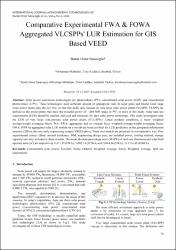Comparative Experimental FWA & FOWA Aggregated VLCSPPs' LUR Estimation for GIS Based VEED
Abstract
Today, the solar power conversion technologies are the photovoltaics (PV), the concentrated solar power (CSP), and the concentrated photovoltaics (CPV). All of these technologies need sufficient amount of appropriate land. In the Supergrids and the Global Grid, the large sized power plants play the key role, so that this study only focuses on the very large solar power plants (VLSPP). The VLSPPs are defined as the power plants that have the installed power of 1.000 MW (peak in PV) or more in this study. There isn't any solar power plant in this size on the world by 2015. Hence, the solar land use requirements should be studied, analyzed and estimated for each solar power technology. This study investigates only the very large concentrated solar power plants (VLCSPPs). Under the unsharp conditions, a fuzzy weighted average/weight averaging (fuzzy WA) aggregated and an ordered fuzzy weighted average/weight averaging (fuzzy OWA) aggregated solar land use requirement models on worldwide basis are built for the land use requirement (LUR) prediction in the geospatial information system investigation studies (GIS) at the very early engineering design (VEED) phase. These two models are presented in a comparative way. Five experimental criteria (direct normal irradiance: DNI, engineering design year, net installed power, cooling method, storage capacity) are only included in these models. This study and its findings will be a good start to design a VLCSPP in the Supergrids and the Global Grid in the following few years.

















